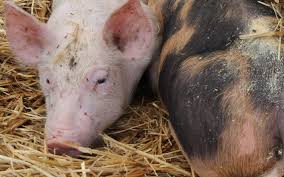
University of Minnesota scientists are collaborating to look at how PRRS virus evolves to understand disease spread, and advance mitigation and control efforts
ST. PAUL, MINNESOTA —- A new grant of nearly $3 million will help University of Minnesota College of Veterinary Medicine (CVM) researchers and collaborators at the University of Edinburgh’s Roslin Institute investigate how porcine reproductive and respiratory syndrome (PRRS) virus evolves and spreads. The research will help scientists and producers anticipate a herd’s susceptibility to different strains of PRRS virus, and customize mitigation efforts accordingly. The data generated could be used to inform future vaccine designs. The grant is funded jointly by the National Institute of Food and Agriculture, National Science Foundation, National Institutes of Health, and the United Kingdom Government’s Biotechnology and Biological Sciences Research Council. It will cover the next four years of research.
PRRS virus costs the US swine industry more than $560 million each year. First described in Indiana, North Carolina, Iowa, and Minnesota in the late 1980s, the virus rapidly spreads within barns and between farms. It has since remained one of the industry’s biggest game changers. Since its emergence in the United States, scientists have worked to reduce its impact.
But while a host may build immunity to a certain strain of PRRS virus after infection, that strain—as with any RNA virus—can counter-evolve to survive in that host and spread. And viruses often compete for hosts—some are better than others at evading the host’s immunity, depending on what that host is used to. This process is called “multistrain dynamics,” and has been investigated extensively in human medicine, but has rarely been explored in animals—until now. This project aims to help farmers understand how PRRS virus evolves, changes, moves, and persists. It also helps producers explore ways of out-maneuvering PRRS virus.
As with many RNA viruses, PRRS virus rapidly evolves and acquires genetic changes over time. However, scientists can study and potentially predict the genetic diversity of PRRS virus in pigs better than they can study other viruses in humans or wildlife because of the rich availability of data—they know where farms are, so they know what the distribution of hosts looks like. They also know how animals are moving between farms, and there is already a lot of ongoing sequencing, so scientists know where and when strains of the virus occur. Researchers don’t have this information readily available for studying the same questions in a human virus.
Kim VanderWaal, PhD, assistant professor in the Department of Veterinary Population Medicine (VPM) at the CVM, is the principal investigator on the project. She says, “Studying PRRS virus’s evolution will help us better understand and hopefully control PRRS virus, but it will also help us understand the evolution and drivers of genetic diversity in viruses in humans and other animals.”
The U of M Veterinary Diagnostic Laboratory has been collecting samples of the PRRS virus for nearly three decades. As part of the grant’s research team, Albert Rovira, DVM, PhD, an associate professor in the VPM, and his team will continue to sequence small parts of RNA from the lab’s collection to determine which samples are new variations of the virus. “We also have hundreds of virus isolates saved in the lab’s freezer,” says Rovira, who notes that these isolates could be used to infect pigs during the research.
The project is partially built on data collected by the Morrison Swine Health Monitoring Project (MSHMP) at the University of Minnesota, which tracks the occurrence of PRRS virus in roughly 50% of the United States’ breeding swine population. MSHMP is coordinated by Cesar Corzo, DVM, MS, PhD, associate professor in the VPM, who is also on the research team for this grant. “One of the reasons Minnesota is so ideally situated for this research is that this dataset is one-of-a-kind,” says VanderWaal.
Another specific asset to this team’s approach is the contributions of Declan Schroeder, PhD, virologist and associate professor in the VPM. Schroeder’s lab was able to develop a new technique that can describe the full genomic strain profile of PRRS virus within 24 hours of sampling. Schroeder says this research can give veterinarians a better tool to rapidly diagnose the infection in animals.
This work is also extremely timely. Another part of this project aims to track the spread of different strains of PRRS virus, including newly evolved ones. “An emergence of a new strain was last seen in 2014,” says VanderWaal. “and we see a general pattern where a significant new type or strain appears every three to five years.”
